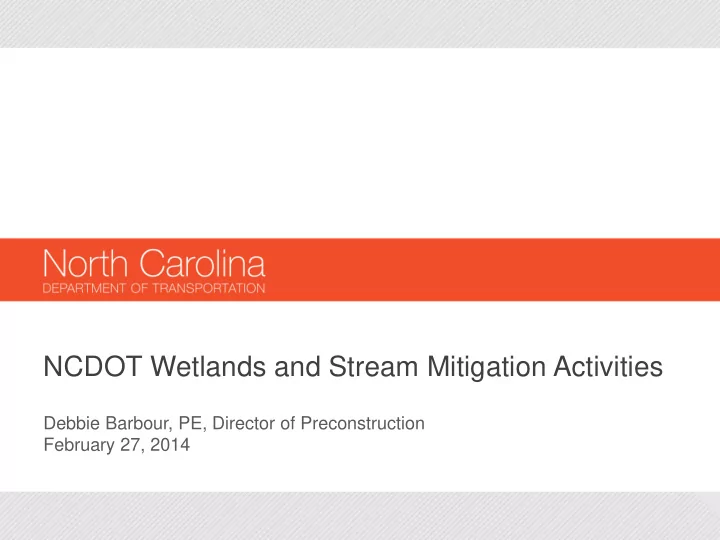

NCDOT Wetlands and Stream Mitigation Activities Debbie Barbour, PE, Director of Preconstruction February 27, 2014
Why does NCDOT need mitigation? NCDOT Mission Statement Connecting people and places safely and efficiently, with accountability and environmental sensitivity, to enhance the economy, health and well-being of North Carolina. • Federal laws require certain permits from the US Army Corps of Engineers and NCDENR if a project impacts wetlands, streams, or buffers 2
NCDOT Wetlands and Stream Mitigation Activities • NCDOT’s mitigation strategies • Why NCEEP was formed • NCDOT/NCEEP Operating Process • Results and Future 3
NCDOT Mitigation Strategies • Prior to 2003 - NCDOT Offsite • Mitigation Sites • Mitigation Banks • Prior to 2003 - NCDOT use of In-lieu Fee Program • After 2003 - NCDOT use of Ecosystem Enhancement Program • NCDOT onsite 4
Prior to 2003 - NCDOT Offsite Mitigation • Mitigation Projects NCDOT was responsible for development of a mitigation project through agency coordination and approval of the site acquisition, plan, design, construction, and monitoring period. • Mitigation Banks NCDOT contracted 14 projects under banking scenarios After 2003 - Credits and management transferred to NCEEP 5
Prior to 2003 - NCDOT use of In-lieu Fee 1996 - Wetland Restoration Program established by state legislation 1998 - MOU between USACE and NCDENR allowed WRP to act as in-lieu fee program and provide mitigation for NCDOT in high-need areas of the state After 2003 - Site credits and management transferred to NCEEP 6
NCDOT Onsite Mitigation Adjacent to Roadway projects • Typically “added value” for right of way required for transportation project and 1:1 impact to mitigation ratio • Most involve stream channel relocation or causeway removal in wetlands NCDOT onsite mitigation strategy continues today, but accounts for a very small portion of NCDOT’s overall mitigation needs. 7
Prior to 2003 - Mitigation Challenges Problem - Mitigation was on the permitting critical path and was contributing to transportation project delays. Reasons - Mitigation delivery was not keeping up with demand and was not being planned early enough in the project development process due to: • Increase in transportation program and impacts • Increase in regulatory requirements • Multiple reviews of mitigation sites and plans • Lack of acceptable mitigation available at permit time 8
Mitigation Process Improvement Initiative Solution – 2001 Interagency Mitigation Process Improvement Initiative launched by NCDOT, NCDENR, and USACE along with participants from USEPA, USFWS, and NCWRC Mission – Develop a structured mitigation process that supports the timely delivery of North Carolina’s transportation program while appropriately compensating for unavoidable and minimized wetland, stream, and buffer impacts 9
NCEEP Established July 2003 through Memorandum of Agreement amongst NCDOT, NCDENR and USACE Purpose - provide stream and wetland mitigation in advance of impacts for NCDOT projects, thereby taking mitigation off the critical path for project schedules. Outcome • Simplified permit process • Allowed highway and mitigation work to progress concurrently and separately • Provided for improved interagency relationships 10
NCDOT / NCEEP MOA Operational process • NCDOT provides NCEEP a list of transportation projects and estimated impacts for each year based on a 7-year STIP highway program • NCEEP develops Operational Strategic Plan to meet NCDOT’s mitigation needs • NCEEP develops biennial budget and requests NC Board of Transportation approval • NCDOT pays NCEEP based on quarterly invoices = ACTUAL COST SYSTEM (pay as work is done) 11
NCDOT / NCEEP MOA Results • No NCDOT projects delayed due to lack of mitigation since the inception of NCEEP • NCEEP has delivered required compensatory mitigation and helped NCDOT to achieve its mission statement • Support of continued funding of NCEEP program to provide mitigation for NCDOT project impacts 12
NCDOT/NCEEP Current Initiative • Collaboratively working to simplify and streamline the coordination process between the two agencies • Increase accuracy of impact projections • Stabilize impact orders • Provide more predictable mitigation costs 13
North Carolina Mitigation Requirements USACE NCDWQ Ephemeral Stream No No Intermittent Stream Case-by-Case Yes Perennial Stream Yes Yes Modified Natural Stream Case-by-Case Yes Ditch Case-by-Case No* Mitigation Threshold Case-by-case 150 LF (generally 150 LF) Mitigation Ratios Case-by Case 1:1 (typically 2:1) *Unless determined to be jurisdictional by the USACE 14
Comparison to Other States NC SC VA GA Mitigation 150 300 300 100 Threshold (ft.) 15
Questions? 16
Recommend
More recommend